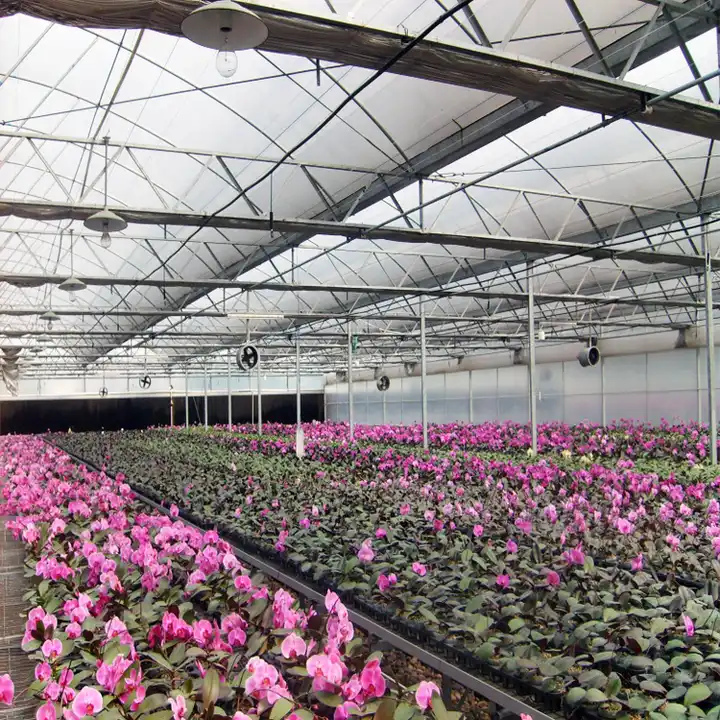The role of a greenhouse tent is to create a controlled environment for plant growth and protection. It is a structure made of transparent materials, such as plastic or glass, that allows sunlight to enter while trapping heat inside.
Here are some key roles of a greenhouse tent:
- Climate Control: The greenhouse tent helps regulate temperature, humidity, and ventilation, creating a favorable microclimate for plants. It prevents temperature fluctuations and provides insulation, keeping the interior warmer than the outside environment. This allows plants to thrive in a controlled and stable environment, extending the growing season and enabling the cultivation of plants that may not be suitable for the local climate.
- Protection from External Factors: The greenhouse tent acts as a barrier, shielding plants from adverse weather conditions such as strong winds, heavy rain, hail, or extreme temperatures. It also provides protection against pests, insects, and larger animals that could damage or eat the plants. By creating a physical barrier, the greenhouse tent helps maintain a more controlled and protected growing environment.
- Extended Growing Season: With a greenhouse tent, it is possible to extend the growing season by starting plants earlier in the spring and growing them later into the fall or even year-round. The controlled environment inside the tent allows for better management of temperature, light, and water, enabling the cultivation of plants outside their normal growing season.
- Improved Plant Health and Growth: Greenhouse tents provide an ideal environment for plant growth. The controlled conditions inside the tent, such as temperature, humidity, and light intensity, can be optimized to promote healthy plant growth, faster germination, and higher crop yields. The protection from pests and diseases also reduces the need for chemical pesticides and allows for more natural and organic cultivation.
- Experimentation and Research: Greenhouse tents provide a controlled space for conducting experiments and research on plant cultivation techniques, plant breeding, and the development of new varieties. Researchers, scientists, and horticulturists can manipulate various environmental factors within the tent to study plant responses and optimize growing conditions.
- Seasonal Plant Propagation: Greenhouse tents are often used for propagating plants from seeds or cuttings. The controlled environment inside the tent promotes successful germination and rooting, allowing for the production of healthy seedlings and clones. This is particularly useful for starting plants early in the season or for producing a large number of plants in a small space.
Overall, greenhouse tents offer a protected and controlled environment that enhances plant growth, extends the growing season, green house tent and provides opportunities for various horticultural activities. They are widely used by gardeners, commercial growers, and researchers to cultivate a wide range of plants in diverse climates and conditions.
Advantages of greenhouse tents
Greenhouse tents offer several advantages for plant cultivation and gardening.
Here are some of the key advantages:
- Extended Growing Season: Greenhouse tents allow for the extension of the growing season by providing a controlled environment. They protect plants from adverse weather conditions, such as frost, wind, or excessive heat, allowing for the cultivation of plants outside their normal growing period. This enables gardeners to start plants earlier in the spring and grow them later into the fall or even year-round in some cases.
- Climate Control: Greenhouse tents provide the ability to control and manipulate environmental factors such as temperature, humidity, and ventilation. This control allows gardeners to create an optimal growing environment for a wide range of plants. They can adjust temperature and humidity levels to suit specific plant requirements, ensuring consistent and favorable conditions for growth.
- Protection from External Factors: Greenhouse tents act as a physical barrier, protecting plants from pests, insects, and larger animals that could damage or eat them. They also shield plants from harsh environmental conditions, including heavy rain, hail, or strong winds. This protection helps maintain plant health and reduces the need for chemical pesticides or other interventions.
- Increased Yields and Crop Quality: The controlled environment inside a greenhouse tent provides favorable conditions for plant growth, leading to higher yields and improved crop quality. Gardeners can optimize factors such as light intensity, nutrient levels, and watering schedules to maximize plant productivity. The protection from pests and diseases further enhances crop quality by reducing damage and minimizing the need for chemical treatments.
- Versatility and Flexibility: Greenhouse tents come in various sizes and designs, allowing for flexibility in terms of space utilization and plant selection. They can be set up in small backyard gardens or on larger commercial farms. Additionally, greenhouse tents can accommodate a wide range of plants, including vegetables, herbs, flowers, and even exotic or delicate species. This versatility makes them suitable for different gardening needs and preferences.
- Energy Efficiency: Greenhouse tents are often designed to be energy-efficient. The transparent materials used in their construction allow sunlight to enter, providing natural illumination for plants. This reduces the need for artificial lighting during the day. Additionally, the enclosed space helps retain heat, reducing heating requirements during colder seasons.
- Pest and Disease Management: The controlled environment of a greenhouse tent helps minimize the entry of pests and diseases. By preventing direct contact with external sources of contamination, greenhouse tents provide a relatively clean and isolated space for plant cultivation. This reduces the risk of infestations and disease outbreaks, making it easier to implement integrated pest management strategies and maintain plant health.
- Space Optimization: Greenhouse tents offer the advantage of maximizing space utilization. They allow vertical gardening techniques, such as trellising or hanging baskets, which can significantly increase the planting area. This is particularly beneficial in small gardens or urban environments where space is limited.
These advantages make greenhouse tents a valuable tool for both amateur gardeners and commercial growers. They offer a controlled and protected environment that promotes plant growth, enables year-round cultivation, and provides opportunities for diverse plant species and gardening techniques.

